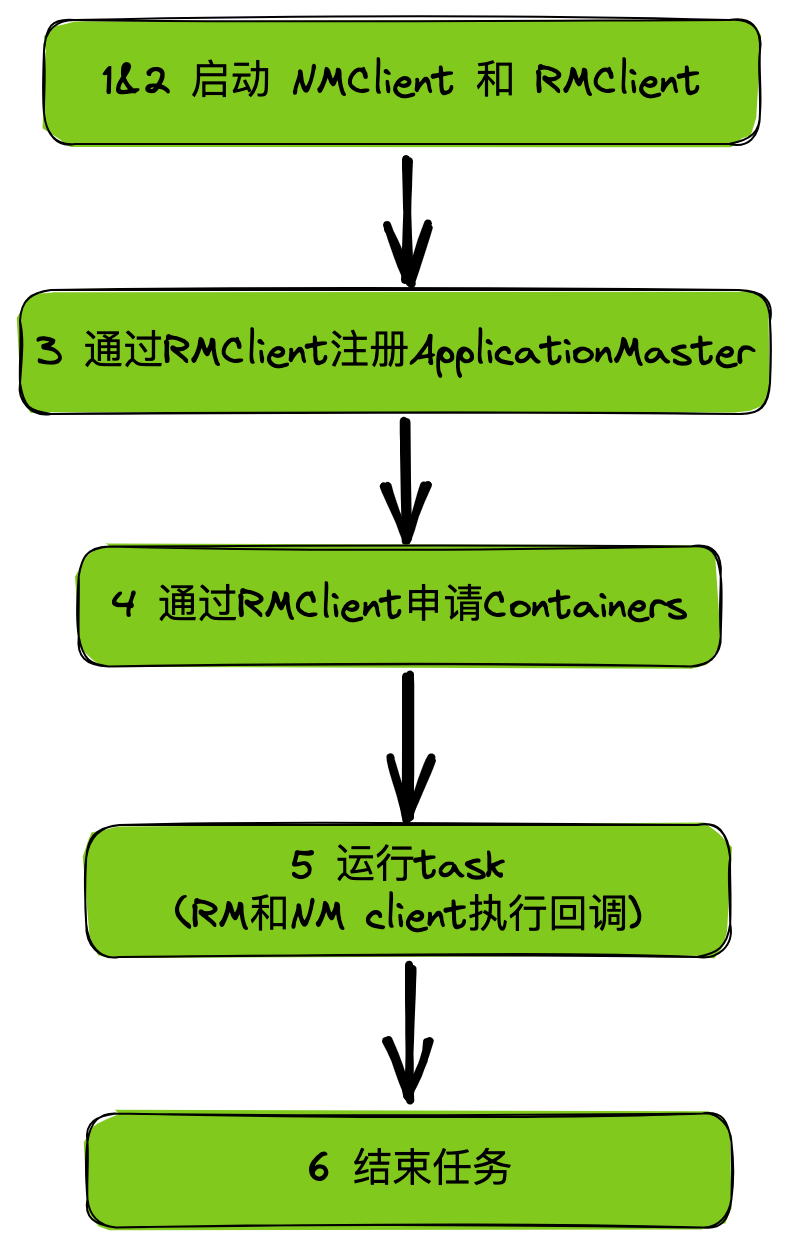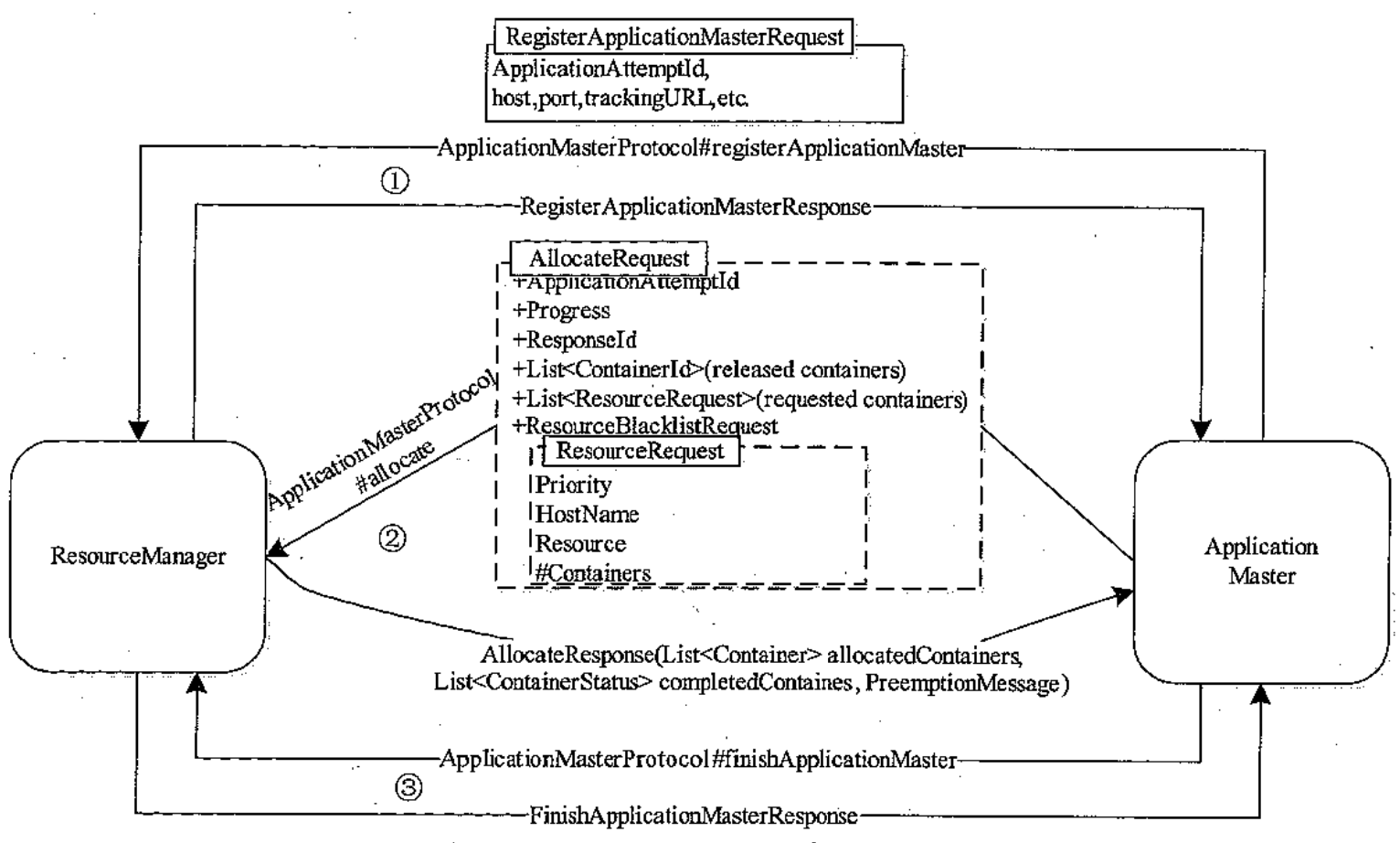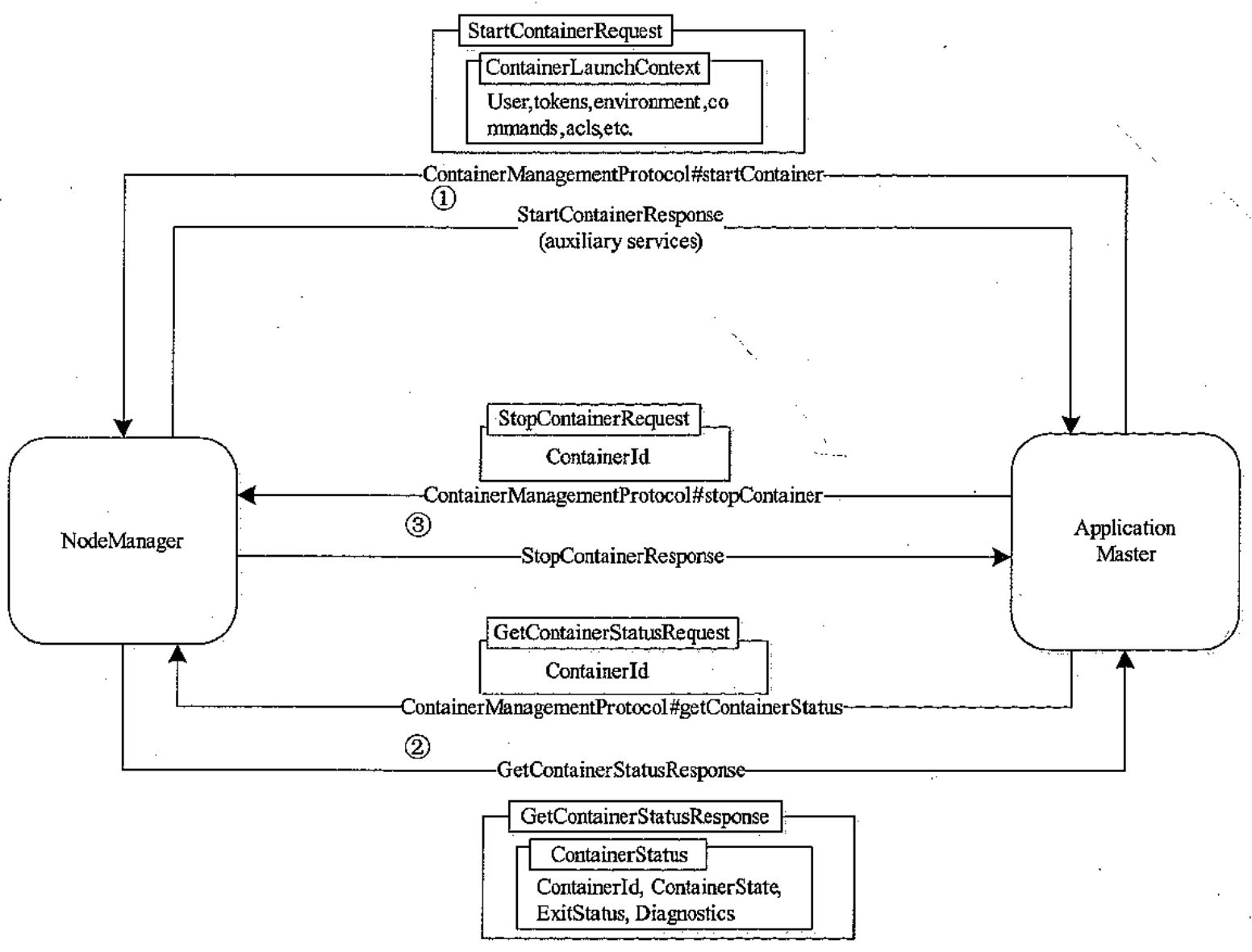【深入淺出 Yarn 架構與實現】3-3 Yarn Application Master 編寫
- 2022 年 11 月 18 日
- 筆記
- hadoop, yarn, 大數據, 深入淺出 Yarn 架構與實現
本篇文章繼續介紹 Yarn Application 中 ApplicationMaster 部分的編寫方法。
一、Application Master 編寫方法
上一節講了 Client 提交任務給 RM 的全流程,RM 收到任務後,由 ApplicationsManager 向 NM 申請 Container,並根據 Client 提供的 ContainerLaunchContext 啟動 ApplicationMaster。
本篇程式碼已上傳 Github:
Github – MyApplicationMaster
一)整體流程

1&2、啟動 NMClient 和 RMClient
在 AM 中需要分別啟動 NMClient 和 RMClient 進行通訊。
兩個客戶端中都註冊了我們自定義的 eventHandler,將會在後面進行介紹。
在 amRMClient 中會定義 AM 向 RM 定時發送心跳的間隔。(在 RM 中會有心跳容忍時間,注意不要超過 RM 配置的時間)
// logInformation();
Configuration conf = new Configuration();
// 1 create amRMClient
// 第一個參數是心跳時間 ms
amRMClient = AMRMClientAsync.createAMRMClientAsync(1000, new RMCallbackHandler());
amRMClient.init(conf);
amRMClient.start();
// 2 Create nmClientAsync
amNMClient = new NMClientAsyncImpl(new NMCallbackHandler());
amNMClient.init(conf);
amNMClient.start();
3、向 RM 註冊 ApplicationMaster
// 3 register with RM and this will heart beating to RM
RegisterApplicationMasterResponse response = amRMClient
.registerApplicationMaster(NetUtils.getHostname(), -1, "");
4、申請 Containers
首先需要從 response 中確認資源池剩餘資源,然後再根據需求申請 container
// 4 Request containers
response.getContainersFromPreviousAttempts();
// 4.1 check resource
long maxMem = response.getMaximumResourceCapability().getMemorySize();
int maxVCores = response.getMaximumResourceCapability().getVirtualCores();
// 4.2 request containers base on avail resource
for (int i = 0; i < numTotalContainers.get(); i++) {
ContainerRequest containerAsk = new ContainerRequest(
//100*10M + 1vcpu
Resource.newInstance(100, 1), null, null,
Priority.newInstance(0));
amRMClient.addContainerRequest(containerAsk);
}
5、運行任務
將在 RMCallbackHandler 中的 onContainersAllocated 回調函數中處理,並在其中調用 NMCallbackHandler 的方法,執行對應的 task。
(RMCallbackHandler、NMCallbackHandler將在後面進行詳細介紹。)
// RMCallbackHandler
public void onContainersAllocated(List<Container> containers) {
for (Container c : containers) {
log.info("Container Allocated, id = " + c.getId() + ", containerNode = " + c.getNodeId());
// LaunchContainerTask 實現在下面
exeService.submit(new LaunchContainerTask(c));
}
}
private class LaunchContainerTask implements Runnable {
@Override
public void run() {
// ……
// 發送事件交給 nm 處理
amNMClient.startContainerAsync(container, ctx);
}
}
6、結束任務
當全部子任務完成後,需要做收尾工作,將 amNMClient 和 amRMClient 停止。
while(numTotalContainers.get() != numCompletedContainers.get()){
try{
Thread.sleep(1000);
log.info("waitComplete" +
", numTotalContainers=" + numTotalContainers.get() +
", numCompletedConatiners=" + numCompletedContainers.get());
} catch (InterruptedException ex){}
}
log.info("ShutDown exeService Start");
exeService.shutdown();
log.info("ShutDown exeService Complete");
amNMClient.stop();
log.info("amNMClient stop Complete");
amRMClient.unregisterApplicationMaster(FinalApplicationStatus.SUCCEEDED, "dummy Message", null);
log.info("unregisterApplicationMaster Complete");
amRMClient.stop();
log.info("amRMClient stop Complete");
二)NMClient 和 RMClient Callback Handler 編寫
1、RMCallbackHandler
本質是個 eventHandler,對事件庫不熟悉的同學可以翻之前的文章「2-3 Yarn 基礎庫 – 服務庫與事件庫」進行學習。
其會處理 Container 啟動、停止、更新等事件。
收到不同的事件時,會執行相應的回調函數。這裡僅給出兩個函數的實現。
💡 思考:之前版本中(2.6之前)還是實現 CallbackHandler 介面,為何後面改為了抽象類?
A:對原介面有了擴展增加了方法 onContainersUpdated。推測是因為避免使用介面繼承。
private class RMCallbackHandler extends AMRMClientAsync.AbstractCallbackHandler {
@Override
public void onContainersCompleted(List<ContainerStatus> statuses) {
for (ContainerStatus status : statuses) {
log.info("Container completed: " + status.getContainerId().toString()
+ " exitStatus=" + status.getExitStatus());
if (status.getExitStatus() != 0) {
log.error("Container return error status: " + status.getExitStatus());
log.warn("Need rerun container!");
// do something restart container
continue;
}
ContainerId containerId = status.getContainerId();
runningContainers.remove(containerId);
numCompletedContainers.addAndGet(1);
}
}
@Override
// 這裡在 container 中啟動相應的 task
public void onContainersAllocated(List<Container> containers) {
for (Container c : containers) {
log.info("Container Allocated, id = " + c.getId() + ", containerNode = " + c.getNodeId());
// LaunchContainerTask 實現在下面
exeService.submit(new LaunchContainerTask(c));
}
}
// 其他方法實現……
}
private class LaunchContainerTask implements Runnable {
Container container;
public LaunchContainerTask(Container container) {
this.container = container;
}
@Override
public void run() {
LinkedList<String> commands = new LinkedList<>();
commands.add("sleep " + sleepSeconds.addAndGet(1));
ContainerLaunchContext ctx = ContainerLaunchContext.newInstance(null, null, commands, null, null, null);
// 這裡去執行 amNMClient 的回調
amNMClient.startContainerAsync(container, ctx);
}
}
2、NMCallbackHandler
定義 nm container 需要執行的各種事件處理。
private class NMCallbackHandler extends NMClientAsync.AbstractCallbackHandler {
@Override
public void onContainerStarted(ContainerId containerId, Map<String, ByteBuffer> allServiceResponse) {
log.info("Container Stared " + containerId.toString());
}
// ……
三)涉及的通訊協議
AM 與 RM

AM 與 NM

二、小結
至此我們學習了編寫 Yarn Application 的整體流程和實現方法,相信各位同學對其有了更深的認識。之後可以從 hadoop 提供的 DistributedShell 入手,再到其他框架(Hive、Flink)等探究工業級框架是如何提交 Application 的。
參考文章:
Hadoop Doc: Writing an ApplicationMaster (AM)
《Hadoop 技術內幕 – 深入解析 Yarn 結構設計與實現原理》第四章


